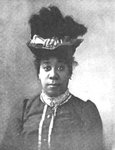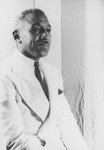 Narrowsburg
NarrowsburgLight Rain Fog/Mist, 43°
Wind: 8.1 mph
REGION — “Think about a future where Black people not only exist, but thrive,” said Dr. Eve Dunbar.
But can you imagine a future when you don’t own your past?
Dunbar, …
Stay informed about your community and support local independent journalism.
Subscribe to The River Reporter today. click here
This item is available in full to subscribers.
Please log in to continueNeed an account?
|





This is only a partial list of the many books, works of art, movies and music available that are considered Afrofuturistic. Find them at your local library or order them through interlibrary loan.
Books
“Beloved,” by Toni Morrison
“Song of Solomon,” by Toni Morrison
“Of One Blood: Or, the Hidden Self,” by Pauline Hopkins
“The Comet,” a short story by W.E.B. DuBois
Works by Samuel R. Delany
Works by Octavia Butler
“Black Leopard, Red Wolf,” by Marlon James
“Moon Witch Spider King,” by Marlon James
The “Children of Blood & Bone” trilogy by Toni Adeyemi
The “Broken Earth” trilogy by N.K. Jemisin
“Biniti: the Complete Trilogy,” by Nnedi Okorafor
“The Deep,” by Rivers Solomon
“The Intuitionist,” by Colson Whitehead
“Rosewater,” by Tade Thompson
Music
Sun Ra
Funkadelic
Parliament
Janelle Monae
Betty White
Earth, Wind & Fire
Grace Jones
Prince
Erykah Badu
Afrika Bambaataa & Soulsonic Force
Flying Lotus
Shabazz Palaces
Lil Nas X
Jimi Hendrix
Films
“Black Panther”
“Space is the Place”
“Supa Modo”
“Brown Girl Begins”
“They Charge for the Sun”
“Sankofa”
“Blade”
“Brother from Another Planet”
“Crumbs”
List courtesy of Rosemary Farrell, senior librarian, Nyack Library, Nyack, NY.
River muse
REGION — “Think about a future where Black people not only exist, but thrive,” said Dr. Eve Dunbar.
But can you imagine a future when you don’t own your past?
Dunbar, professor of English at Vassar College, focuses on African-American literature. Afrofuturism, the use of the arts to portray a different future for Black people, is both literature and an idea that pushes its boundaries.
Why literature? Why does it matter? Because “literature helps us reimagine the world,” she said. “Black writers speak about the Black condition… [and] model possibilities.”
That’s Afrofuturism in a nutshell. Often classed as science fiction, the term encompasses not just literature—and not just genre fiction—but music, art, and cinema.
Afrofuturistic books put Black people and Black culture front and center. What are the characters’ lives like in these imagined worlds?
Writers and scholars of Afrofuturism all approach the subject differently. Dunbar said she was interested in “What if, then what” would happen? “I like to imagine the future, imagine the change.”
Here’s an example from 1931. In George Schuyler’s novel “Black No More,” a scientist invents a process to turn Black people white. Who opts to change? What do the white people do? Does changing skin color help?
But Afrofuturism also pushes you to dig deeper.
It reminds us, Dunbar said, about the impact of telling people that their past doesn’t matter, that they themselves don’t matter, and that they have no future.
The books, the movies, call that a lie, and offer images and stories about what could be.
Time, in Afrofuturism, is fluid. It’s like magma, liquid and dangerous, especially when it erupts into people’s lives.
Imagining a future hinges on reckoning with the past, and slavery is the foundation, Dunbar said.
It begins with suffering. For Black people—African Americans, Islanders, Africans, people of color who identify as Black—“the transatlantic slave trade binds us all.”
So many were chained up and sent away, to the United States or the West Indies. Others were left behind, living under colonialism and with the memories of the people who were stolen.
“They are shared experiences, but different filters,” Dunbar said.
Octavia Butler’s “Kindred” plays with time, sending a character, the Black woman Dana, back to the antebellum South and into slavery, saving her white ancestor’s life so her family will exist in the present.
As Dana’s time spent in the past grows longer, she struggles with the repressed trauma of slavery, the genetic memory of suffering and how it echoes down the generations.
There’s another angle to this: even as people were owned, so was their past, and it, like the slaves themselves, could be redefined and disposed of at will.
In a recent Zoom discussion of Afrofuturism, sponsored by the Nyack and E.B. Crawford libraries, Dunbar played the museum heist scene from the movie “Black Panther.” In it, Killmonger challenges the curator on the origins of the displayed items and then repatriates them.
Weapons, shields, masks: they were all stolen by white people, and the thieves rewrote the details of the theft and the description of the items.
“How do we speak to a future when the past has been stolen?” Dunbar asked. Can that past be recovered and the stories corrected?
What has happened, has happened. We deal with the fallout. But Dunbar asks, “Can we reimagine our present actions to change the future?”
Dystopia, for instance, can be “a what-if question. How would I survive? But it’s also an opportunity for people to say, ‘I don’t want it to come to this.’”
For some, the future looks bleak without a hard change, without burning it down and starting over. In the Zoom talk, Dunbar played a trailer for “Space is the Place,” a 1974 movie by jazz musician and filmmaker Sun Ra, that suggests the only way Black people can find hope is to leave the planet.
There’s a card game with the white Overseer, to determine the fate of Black people everywhere; Sun Ra wins by walking away and taking his people with him.
“It’s a world in which Blackness is differently engaged,” Dunbar said, “so people can think about who they are… You have to see the system and understand how you fit into it. To learn about the human condition, and how you too are dehumanized.”
“You project the African American experience beyond this moment while reckoning with the past,” Dunbar said. “We deserve a future.”
Getting to that future isn’t easy. She cited writer Kiese Laymon’s list of needs: healthy choices, second chances and good love. “We’re all worthy of the opportunity to have them.”
But then you add this: “Certain bodies are marked as disposable.”
And this: “Class issues, gender issues.”
Layer on race.
Layer on a past where your ancestors were brought here in chains.
The more of these layers you carry, “the more marginal you are, and the more you have to keep struggling against this,” Dunbar said.
And that is where the arts come in.
The arts take you “up the mindscape,” she said. “You do matter. You are more than the body that labors.”
Afrofuturism is Black science fiction but it’s also more. Hope isn’t zero-sum: when we lift up people who have been crushed, we offer hope for all.
“If you open yourself to minoritized writers and characters, that reading does you good. We do each other a service, really listening and understanding,” Dunbar said. “If we’re going to make it, we have to build it better.”
Related stories

Comments
No comments on this item Please log in to comment by clicking here